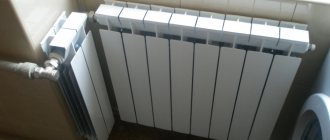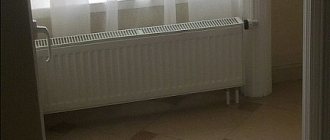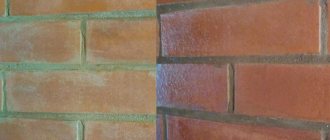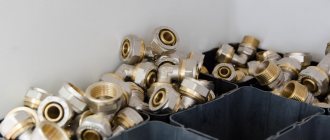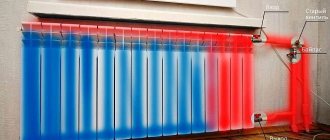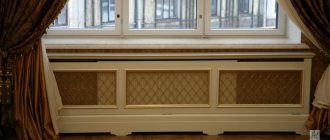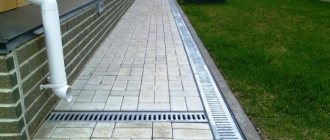Heating devices are an essential element of any water heating system. They are usually the most expensive part. A good opportunity to save money would be to use homemade radiators. They are made from smooth round steel pipes or from profile pipes. The latter option is somewhat more expensive, but allows you to reduce the depth of the device and get a more aesthetic appearance.
The use of a profile pipe for the manufacture of heating registers has a number of features. When starting to work with your own hands or deciding to buy a “homemade” product, you need to carefully weigh the pros and cons. Studying the basic rules by which heating registers are made from a profile pipe will help you avoid mistakes when working independently and will make it possible to make a competent choice of the necessary parameters.
Features of homemade radiators made of metal pipes: types and characteristics
Experienced craftsmen know that the use of profiled and round pipes made of carbon steel for the manufacture of heating devices has its own specifics. Therefore, studying the basic rules for assembling homemade heating registers will help in the future to get rid of errors and make an informed choice of parameters.
Design of a homemade heating battery
The design of such devices is a system that consists of horizontal or vertical pipelines interconnected by jumpers. Smooth pipes with a round cross-section are used for the production of heating radiators much more often than analogues with a rectangular or square profile. However, combined designs are also possible.
Without a doubt, registers made of carbon steel are considered the most convenient to use. The option made of galvanized or stainless steel looks much better in terms of characteristics. But, firstly, it is expensive, and secondly, only experienced specialists can work with such material.
Homemade heating devices are suitable for both single-pipe and two-pipe systems. They can be wall and floor mounted. The simplest example of execution is a heated towel rail in bathrooms. Handicraft registers are divided into two main types:
- Sectional.
- Serpentine.
Section registers
They are a pipe structure, where elements of a larger caliber are parallel and capped at the ends, and tubes of a smaller cross-section serve as connecting elements. For strength, additional jumpers can be used.
The coolant in such a battery always moves from the top tank, then through the connecting pipes it passes to the bottom row, and so on. This scheme practically eliminates the situation when the radiators are hot and the house is cold.
Judging by practical application, sectional registers cope with their tasks quite well. However, there was a fly in the ointment here. During operation of the device, it will not be possible to get rid of high hydraulic resistance; the reason for this is the difference in the diameters of the pipes and jumpers.
Serpentine registers
Such batteries look like an S-shaped structure assembled from components welded in series. The main advantage of this solution is that the diameter of the pipes is the same, which means that the hydraulic resistance is quite low. For the same reason, the coil is effective, since heat exchange is carried out over the entire surface of the homemade radiator.
A register bent from solid pipe is much more reliable in terms of operation than a welded one. But, unfortunately, it is almost impossible to carefully bend a steel pipe with a diameter of 70-100 mm at home - ideally, you need a pipe bender, and in extreme cases, a gas torch. This is where register prefabricated structures come to the rescue.
The heating system with S-shaped radiators, assembled only from metal pipes, is particularly reliable and durable; moreover, it is not so difficult to carry it out step by step. Compared to sectional batteries, there are significantly fewer welds, which means there are fewer potential sources of leakage.
Characteristics of homemade heating devices
Registers of this type can withstand pressure up to 10 kgf/m² and are able to work with any coolant: water, oil, antifreeze and steam. The permissible cross-section of pipes used in sections must be in the range of 32-219 mm.
Which pipes are better for heating?
Pipes made of ordinary steel are practically no longer used in houses and apartments - the tendency to corrosion outweighs their other advantages. If homeowners want to install a heating system that does not require worries and hassle for many years, then they should choose pipes made of copper or stainless steel. Their service life is more than 50 years, theoretically it can reach 100 years. Installation is moderately complicated, but the costs are more than offset by durability.
Galvanized steel pipes can be very durable only under one condition: if all parts of the pipes are coated with zinc. In reality, all parts of the pipeline must be galvanized after threading and installed using galvanized threaded fittings. When installing home heating systems, it is impossible to organize galvanizing of all workpieces.
Conclusion: it is better to install pipes made of stainless steel and copper. In terms of quality, these materials are quite equivalent, and the choice is only a matter of personal preference. Copper pipelines are more compact.
Basic heating register calculation
If the level of heat transfer of a purchased battery can be found out from its passport, then in the case of homemade heaters you have to calculate everything yourself. Otherwise, it will not be possible to heat the room effectively and evenly.
Calculating the required radiator power to heat a room
For calculations, they use formulas that may be simple, but require certain mathematical skills. Another option is online calculators, of which there are now more than enough on the Internet. Strictly speaking, the topic is quite extensive and deserves a separate article, so we will use simple calculation methods. In any case, this issue should be given close attention, otherwise your family will complain that the radiators do not heat well and the room is cold.
A simplified method for calculating the required thermal energy is to calculate the heating area and then multiply by 100. Why is this so? Because for comfortable living per square meter you need 100 W of heat. To be more precise in the calculations, let’s take into account the number of window openings and walls:
- A room with one window and one external wall – 100 W per 1 m² of area.
- A room with one window and two external walls - 120 W per 1 m².
- A room with two windows and two external walls - 130 W per 1 m².
Important! The calculations are suitable for rooms with ceilings of no more than 3 meters, when the house is located in a moderate climate in the middle zone. If the building is located in the northern regions, then the result must be multiplied by a factor of 1.2-2.0, and if in southern latitudes - by 0.7-0.8.
Simple calculation of the thermal power of a radiator made of steel pipes
Knowing what to strive for, all that remains is to choose the design of the heating device that would satisfy your needs. How to do this?
There is an elementary solution - use a table. It already calculates the heat transfer rates of rolled pipes. The values take into account the temperature regime, in which the supply temperature of the coolant is +90℃, and the return temperature is +20℃.
So, the table below allows you to find out the thermal power of one linear meter of register pipe per square meter of heated area.
| External section of the pipe, mm | Heated room area, m² |
| 25 | 0,5 |
| 32 | 0,57 |
| 42 | 0,69 |
| 57 | 0,94 |
| 76 | 1,19 |
| 89 | 1,37 |
| 108 | 1,66 |
| 133 | 2,0 |
| 159 | 2,43 |
Important! Keep in mind that calculations based on square footage alone are fairly rough estimates. It is advisable to use special formulas that use the temperature conditions of the system and the linear parameters of the radiator.
What other quantities do you need to know?
So, we have decided on the option - all that remains is to draw up a drawing. At this stage, such a parameter as the distance from section to section – h – is often forgotten.
When assembling a coil-type radiator from steel pipes, this value is determined by the dimensions of the bends used. Here it is worth paying attention to the value of F - this is the so-called outlet height. Without a doubt, the intersection distance here will be expressed by the formula:
h = 2F-D
If you decide to assemble a simple sectional radiator, then the gap between the pipes can be set independently, but with one condition:
H = D+50 mm
The same principle applies when working with rolled profiles, only instead of the diameter the height of the square or rectangular profile is used. Of course, the design features of the device are taken into account.
Answers from experts
Tori:
plastic pipes and aluminum radiators.
LegendaSporta:
polypropylene.
mu.rza:
we bought polypropylene ones. each has its pros and cons. Read this, a very informative article about pipes
Vladislav Ushkalov:
Igor Shkurny:
Polypropylene... have less trouble with it... unless of course you have a soldering iron!!!!
Lizard:
I bought a house with completely defrosted metal pipes and cast iron radiators. I chose, consulted, changed to polypropylene and aluminum batteries. I bought one cast iron. and what? It was she who cracked in the very cold (there was no heating, and there was antifreeze in the pipes, but it did not help). I also changed it to aluminum. Further, in the well next to the house there is water supply for five houses, each has its own valve, the pipes are all iron. They rusted like hell. When it burst again, I raised a fuss, collected money from the people, and the local master replaced the filling of the well with polypropylene again. Now we are all calm. So polypropylene is perhaps more reliable. Some people claim that pipes made of polyethylene (very dense) are even more reliable and are not afraid of frost at all, but I don’t know.
Floors:
Iron pipes are 3-5 times cheaper and much more reliable than propylene and plastic. The disadvantage is corrosion of the metal from the inside, which cannot be gotten rid of in any way, but if the water is not drained from the system, then after cutting a 20-year-old pipe, it is as good as new inside (I myself have cut old heating pipes more than once - there is almost zero corrosion inside. And heating devices are more aesthetically pleasing than aluminum and bimetal. USSR cast iron is no longer in fashion, and the material consumption is appalling)))
Sergey Rudin:
Look here: agrosad m /catalog/tverdotoplivnie_kotli_1
Solo:
In a private house AOGV. ) There seem to be no other options.
Andrey:
rephrase the question. A radiator heating system is one thing, but pipes and radiators are a completely separate issue.
Alexander Bonn:
Gas boiler, steel radiators, welded pipe. Energy consumption: 10 sq. m = 1 kW. For a private house, warm floors (1st floor) and radiators are combined. But there must be an emergency heating system (electric or solid fuel).
Alasseia:
question about heating a spherical house in a vacuum, no information about the source of energy supply, no information about the house itself, what would I recommend - a project for heating your bungalow completed by a specialist
F F:
Boilers, boiler equipment. Heating 2 x storey house. : // forum .domostroy /#gazosnabjenie-vodoprovod-otoplenie-konditsionirovanie Gas wall-mounted boiler Heating, plumbing, sewerage for a house or cottage. Heating 2 x storey house.
Which radiators or pipes are better? - it is necessary to rely on the volume of coolant for the correct operation of the boiler! example - 70 sq. wooden house, - they wanted a fan system with aluminum. heating radiators, after calculating the amount of coolant, we chose a register system of pipes.
For a brick house, combine heated floors (1st floor) and radiators, a fan distribution system, and metal-plastic in a screed. Alexander Bonn +++
alexm66:
The question is very general: which is better, a foreign car or a VAZ - for which there is money and opportunity. I think the main criterion is the reliability of the equipment, and a competent installer will be able to make a workable system out of it, but an illiterate one will ruin any “luxury” equipment.
Making sectional heating batteries from metal pipes using a homemade method
Tools
To make a register yourself, let’s prepare the necessary tools:
- Welding machine, electrodes and protective mask.
- Grinder, electric drill, abrasive wheel and metal drills.
- Hammer, gas wrench, building level, tape measure.
- Vise, clamps, brush with metal bristles.
In addition to a protective mask for welding, it is worth taking a special suit, gloves and strong boots or boots.
Necessary materials
For example, let's take the manufacturing process of the radiator shown in the drawing. It consists of 4 sections one meter long. Material – 108 mm steel pipe. In addition to all of the above, at a minimum, you need two ball valves. They are placed at the input and output of the device; in addition, you can connect a tap to the upper section of the battery to bleed air from the system.
| № Positions | Detail | Part parameters | Quantity |
| 1 | Steel pipe | Ø 108 mm (DN 100) | 4 |
| 2 | Impassable jumper | Ø 48x3.5 mm (DN 40) | 3 |
| 3 | Passage jumper | Ø 48x3.5 mm (DN 40) | 3 |
| 4 | Male thread fitting | G1/2″ (DN 15) | 2 |
| 5 | Elliptical end cap | Ø 108 mm (DN 100) | 8 |
Important! Think about register installation options in advance. These can be powerful stands or brackets. In any case, the finished battery will have quite a lot of weight, and this is not counting the mass of the coolant.
Assembly technology
- The first stage is marking and cutting pipe blanks. Their inner surface must be cleaned of rust and burrs so that nothing interferes with the circulation of the coolant.
- The next step is preparing the stubs. If necessary, they should also be cleaned of rye. Holes are drilled in two for mounting fittings.
- Insert and weld fittings into the holes, weld plugs onto the ends of the pipes.
- Using the drawing dimensions, mark the places where the jumpers are attached. On pipes Ø 108 mm, where there will be passage channels, drill holes according to the diameter of the jumpers. Be careful when marking!
- Weld passage jumpers onto the horizontal sections where the holes were drilled; where there are no holes - impassable. A tandem of jumpers will unite the sections and form the correct direction of coolant movement.
- Clean all welds. Check the device for leaks: close the lower radiator fitting and fill it with water through the upper one. If even a minimal leak appears, the water is drained and the defect area is additionally boiled.
- After checking, the surface of the sectional heating radiator made of metal pipes must be painted with heat-resistant paint. This treatment will protect against corrosion and add aesthetics to the product.
Why choose metal for heating systems
For more than twenty years there was practically no alternative to pipes made of steel - carbon (in common parlance, ferrous metal), galvanized, stainless. The use of copper for heating was unheard of at that time; plastic pipes were not mentioned even in progressive scientific journals. Now the situation has changed radically: several types of inexpensive high-tech plastic have greatly displaced metal from heating systems.
However, metal pipes are still indispensable in many situations: when systems operate at very high operating pressures, in hot shops, when high strength is required from pipelines.
Subtleties of installing homemade registers
Actually, the procedure is not much different from installing factory heating devices. The only difference here is the weight and dimensions of the structure. However, keep in mind a few simple rules:
- The distance between the battery and the wall should be at least 25 mm, and the same to the floor. From top to window sill - at least 50 mm.
- When assembling threaded connections for sealing, use paronite gaskets, FUM tape or tow with sealant.
- The slope of the underwater pipes in relation to the register should be 5-10 mm per meter in the direction of the coolant movement. When the line length is less than 500 mm, it is not necessary to make a slope.
- The installation part of the work should be carried out before the onset of the heating season - this way you can do a test run of the heating system, check its tightness and design power.
Briefly about the cost where to buy
The price of metal structures is indicated either per meter or per ton. Be sure to pay attention to this point. The cost of metal channels varies over a very wide range. The price depends on the quality of the material, production technology, wall thickness and other properties of the product.
Structures made of black steel are the cheapest. Next comes galvanization, which costs a little more. Stainless steel is the most expensive. However, as you have already learned, pipes made from it are the most reliable. Corrugated stainless steel channels are the most expensive.
The easiest way to order the products in question is from companies specializing in the sale of rolled metal products. It is advisable to deal with structural manufacturers or their official dealers. This will allow you to purchase the products you need at an affordable price.
In some cases, it makes sense to buy used pipes. The main thing is that they are in good condition. When purchasing, be sure to ask for a certificate of conformity. This will allow you to avoid purchasing inferior products.
Checking the device
The homemade radiator is ready. As you can see, it is not very difficult to make. All that remains is to check it for the tightness of the welded joints. To do this, one of the drains is closed with a plug, and water is poured into the battery through the second.
Now you need to examine the weld seams. If there are no wet smudges, then all the work was carried out efficiently. If stains do appear, you will have to mark the leaks with a marker, drain the water from the radiator and re-steam the seam.
Material of manufacture
If you make a selection depending on the material of manufacture, then the registers can be classified into the following categories:
- Steel;
- Aluminum;
- Cast iron.
Which heating registers are best to choose? Steel registers became the most common. Their connection to the heating system is carried out by threading or welding. Such devices have good heat transfer and reasonable cost.
Aluminum registers are much lighter than steel registers. In addition, they are resistant to corrosion, are made without connecting seams and have good heat dissipation. The main disadvantage of such devices is their very high price.
Registers made of cast iron are connected to the heating system using a flange connection. They are quite easy to install and inexpensive. The disadvantages of cast iron products include low inertia, which significantly reduces the heating time of the registers.
Key purpose
In most cases, finned tubes are used to heat any liquids. The equipment is exposed to a heat source. As a result, the copper transfers it to the liquid passing through the heat exchanger. This way the water is heated. The cost of using such heat exchangers is quite high. The heat transfer efficiency of these products is greater than that of standard pipes.
Finned tubes provide fairly fast heating. They are often used as a heat exchanger in boilers intended for heating and hot water supply. This product can also be used for cooling. But in this case, their effectiveness will not be so high. To improve performance characteristics, products are subjected to additional stimulation.
The equipment in question is used in:
- Chemical and oil refining industries. The gas heaters and coolers used, as well as condensers, have equipment of this type in their design.
- Nuclear energy. The products are used in a variety of drying towers, air heaters and other devices.
- Mechanical engineering. In most cases we are talking about turbine compressors and freezing equipment.
- Air conditioning systems. Typically the products are used in cooling units and condensers.
- Heat exchange devices of various types. Many of them use copper finned tubes.
Error correction
Sometimes, incorrect measurements of a room lead to incorrect calculations. The installed heating radiator does not work efficiently and the room is cool. You should not immediately rush and make a new device, spending both time and money. There is a way to increase thermal output.
To do this, it is necessary to increase the heating area. The only option in this case is to weld ribs made of a metal sheet 1.0-2.0 mm thick to the pipe structure. The shape of the ribs can be different, the main thing is their area.
Therefore, for example, rectangular pieces with a length greater than the height of the radiator and a width of 100-150 mm are cut out of a sheet of iron. Semicircles with a diameter of 100 mm are cut into them on one side. On each piece of sheet there are two semicircles, the distance between which is determined by the gap between the two pipes in the battery.
The finished forms are welded to the heating structure. The more there are, the higher the heat transfer of the device.
Heating radiators are elements of engineering plumbing systems that are functionally designed to heat the air in a room. According to SNiP (2.03.01-84), radiators that comply with heat balance calculations should be used in any room. They are quite sufficient to maintain normal temperatures inside buildings.
However, for a garage or small workshop it is better to make a heating register yourself. In terms of dimensions and heat transfer, this device goes beyond the parameters of classical designs, but is much more suitable for these premises. The article we presented describes in detail the technology of its manufacture.
Main selection criteria
Any specialist has a whole arsenal of tools that help him make the right choice. Each type of pipe has both positive and negative characteristics. Therefore, taking them into account, it is not difficult to find the optimal solution. Much also depends on knowing what heating systems exist and what engineering conditions must be met
Here is a list of basic initial data that must be taken into account when choosing heating pipes:
- Availability of forced or gravity heating system
- Laying method - internal or external
- Complex or simple system configuration.
- System pressure power
- Maximum water temperature
Below is a list of existing options. It will help you decide correctly which pipes to choose.
Floor waterproofing
In order for the heating system to work more efficiently, it is important to take into account other factors that affect the internal climate in the house. For example, often paying great attention to the insulation of windows, walls, doors and ceilings, they completely forget about the huge floor areas in the house. To insulate them, you can use modern waterproofing of the subfloor.
Insulation options
There are three main types of waterproofing the floor in an apartment before screeding. It is simply necessary not only for heat conservation, but also for sound insulation and protection of the lower floors from water leaks in case of accidents. The floor can be insulated as follows:
- Pasting. Special insulating materials are laid in even layers on top of each other and securely fastened.
- By painting. There are special mixtures that are applied with a brush to the insulated surface in several layers. The main disadvantage of this method is its fragility.
- By pouring. A special cement-bitumen mortar is prepared and poured evenly into the room.
- By pouring. This method is used in houses without a basement. An insulation cushion is made from crushed stone and sand.
- Combined. Most often, several methods are used at once.
Build process
First of all, you need to prepare, i.e. purchase all necessary materials. We cut a pipe with a diameter of 100 mm into two halves 80 cm long; for this you can use a grinder.
Next, we cut 2 pieces of 100 mm length from pipes with a diameter of 25 mm, and 4 pancakes are cut from a steel sheet for an outer diameter of pipes of 100 mm.
Then two holes with a diameter of 25 mm are cut out in 100 mm pipes - their location from the edges should be at a distance of 50 mm on diametrically opposite sides.
After this, you can assemble the structure. First, pancakes cut from sheet iron are welded. Then two 100 mm pipes are connected to each other with a 25 mm pipe, exactly along the cut holes.
The second piece of 25 mm pipe is welded on the opposite side; it will serve as a reinforcing element, after which two bends are welded: top and bottom.
Practical heating registers: what to choose for your home and apartment
On the market, everyone can choose heating registers for installation in an apartment or private house. On sale there are designs made of metal horizontally located pipes connected to each other by special jumpers, due to which water moves through the heating device. Modern registers have higher heat output than traditional Soviet batteries. The most popular aluminum registers have the best technical characteristics. Homemade batteries are used in small apartments or rooms, ensuring proper heating of the available space.
Specifications
Finned tubes have strong advantages over standard products. The equipment is characterized by:
- Low thermal resistance of heat transfer during condensation of coolant vapor inside the products. This occurs due to the reduction of condensate film.
- High-quality temperature contact located between the ribs and the supporting tubular product.
- High intensity of convective heat exchange, as a result of the absence of low-quality finned fragments and turbolization of flows in the channels located between the fins.
- High technology. This is due to the use of modern equipment, which ensures low consumption of raw materials and energy.
The peculiarity of copper finned pipes is their resistance to corrosion processes. Long service life of heat exchangers. The product has sufficiently strong resistance to aggressive environments. The most popular is 10 mm finned copper tube. Below you can familiarize yourself with the characteristics of ribbed copper products of different diameters.
The ratio of the total outer area to the outer area without fins is called the fin ratio. To calculate the effectiveness of finned products, it is necessary to take into account the geometry of the fin shapes, the structure of the tube bundle and the thermal conductivity of the manufacturing material.
Results and conclusions.
- I managed to increase the air temperature in the room by as much as 6ºC, and in extreme fan operation mode even by 9ºC, which confirmed the assumption that it is possible to increase the heat transfer of a central heating battery, even at such a low coolant temperature.
- When using a regular household fan without a speed controller, the room becomes too noisy. However, if you use the heat accumulated in the room, then, for example, you can turn off the fan in the bedroom at night, and, on the contrary, turn it on in the dining room. Then you can use the fan at full power.
- If you are in that part of the room where the movement of air generated by the fan is most noticeable, then a false sensation of a decrease in temperature is created.
- Those who are afraid that the fan will wind up a lot can calculate the monthly energy consumption.
35(Watt) * 24(hours) * 30(days) ≈ 25(kW*hour)
Additional design features
Some experts advise welding supports or brackets.
This is not very good, because it makes the structure more massive and not universal. Without welded supports and brackets, it can either be hung on the wall or installed on stands fixed to the floor. In some cases, the owner who dismantled the old sectional batteries. using a radiator key and made a device, he could have made a mistake in calculating the optimal dimensions of a homemade radiator. As a result, the design is not able to heat the air in the room to the required temperature. One way out is to make an additional heater. However, you can improve what has already been made.
To enhance heat transfer, vertical metal plates can be welded. They will also heat up and give off heat. Thanks to them, convection will improve.
These plates can be cut from a metal sheet with a thickness of 1.0-2.0 mm. Their features should be as follows:
- Height - greater than the height of the battery.
- Width - 10-15 cm.
- The presence of 3 cut out squares or rectangles on one side. The dimensions must correspond to the dimensions of the profile pipe.
Such plates are applied to the battery and welded. As for their quantity, the more the better, because the greater the heat transfer becomes.
Selecting a heating battery based on the area of the apartment How hot the heating batteries should be Making a solar battery Heating meters for batteries
Product design
The differences between different types of products lie in the shape of the petals and the finning ratio. Industrial production of the group of pipes under consideration can be based on different technologies. It all depends on the purpose of the products.
Let's look at the most common way to create finned copper products. First, a groove in the form of a snake is applied over the entire area of the pipe. This operation is performed on turning equipment using a special cutter.
Then strips of copper are placed in the created grooves under tension. They are pressed inside. Most often, such equipment has an additional heating function. This allows the operation to be performed more accurately and efficiently.
Finned copper tubes come in several varieties. The most popular type are products made entirely of copper. Such products perfectly transmit temperature. It can be used for both cooling and heating.
Another product option is bimetallic products. They are made from copper and steel. The first metal is a layer occupying about fifteen percent of the wall thickness. It can be located both on the outside and on the inside. In some cases, a layer of copper is placed on both sides. It all depends on the purpose of the product.
The advantage of bimetallic pipes is their low cost. You can buy these products relatively inexpensively. The price of a pipe made entirely of copper will be much more expensive. Bimetallic products in some cases are the optimal means for creating a high-quality heat exchanger. These products are widely used in heating systems.
How to make fins with your own hands?
You can create fins on pipes yourself only on small parts of products and only on small-sized workpieces. There are several options for solving the problem. You can achieve the desired result by:
- applying deep threads using turning equipment;
- winding copper wire;
- notches and tension;
- welding;
- notches and welding.
If it is not possible to use a factory finned tube, you must use one of the methods listed above. The required method must be selected in accordance with the technical characteristics of the workpiece and its future purpose. Each task requires careful calculation. Therefore, the issue of applying ribs to pipe equipment must be treated with extreme caution.


